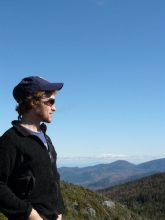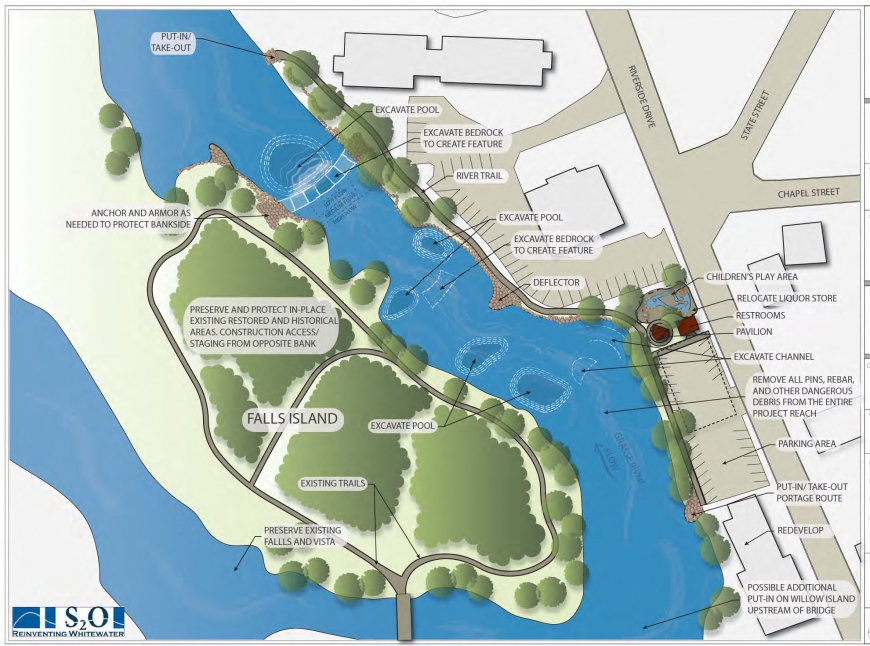
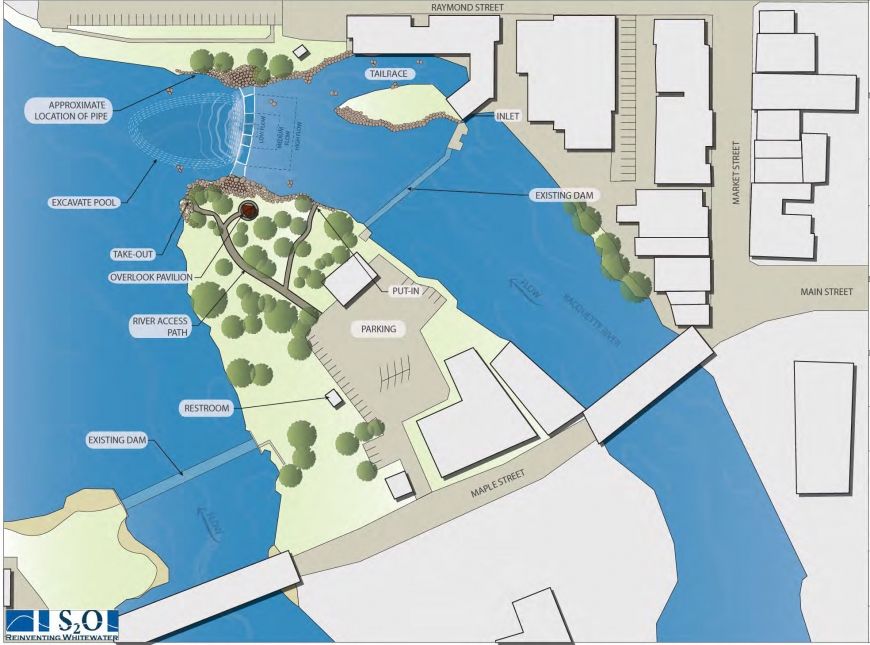
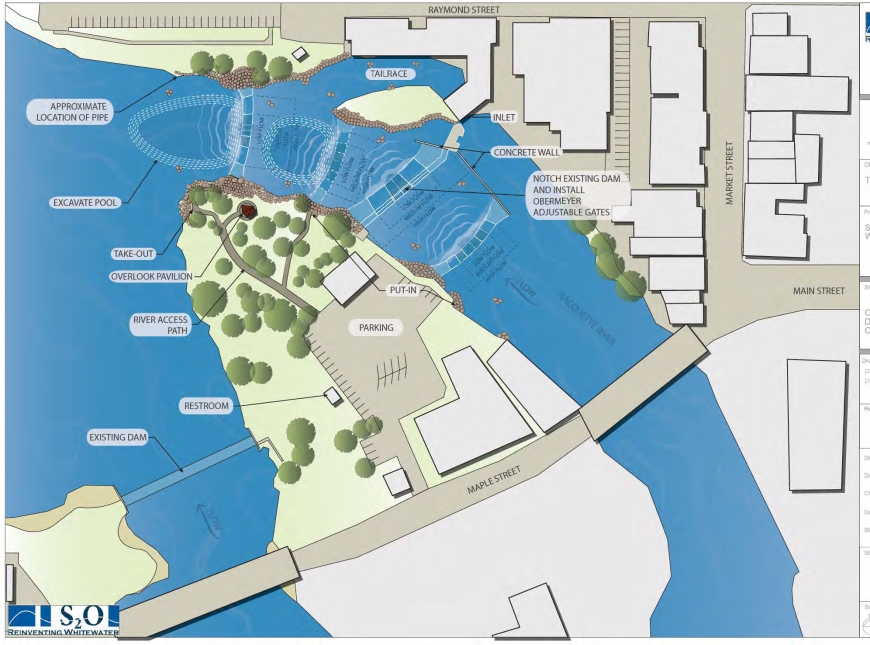
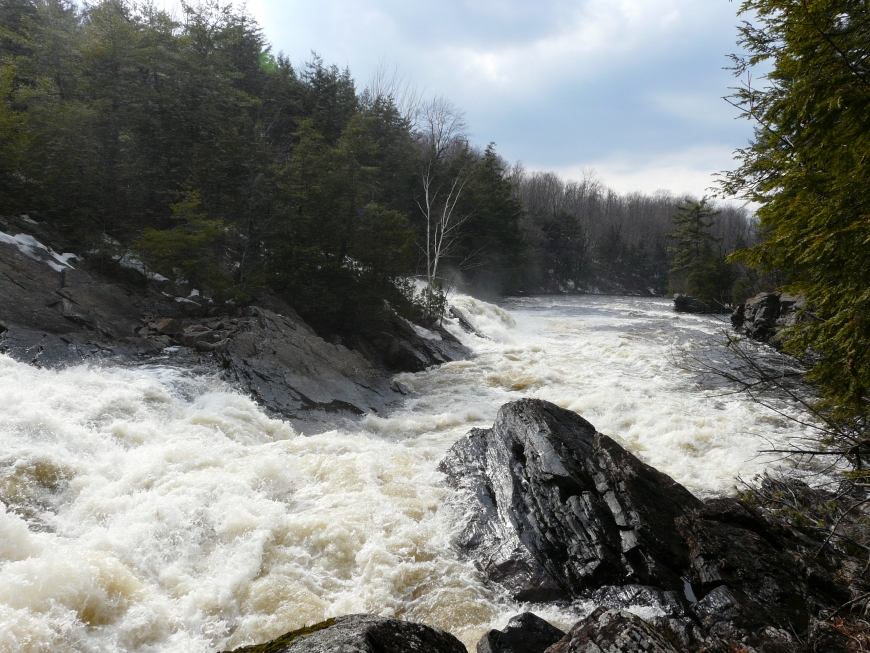
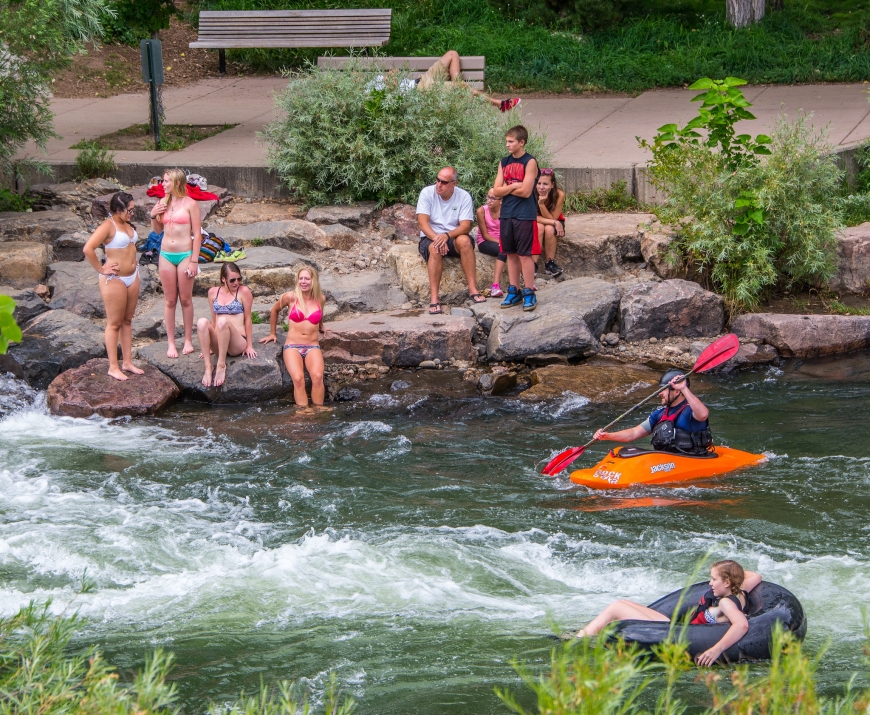
The proposed Canton site. Source: S2o Design
Phase 1 of the Potsdam Whitewater Park. Source: S2o Design
Phase 2B of the Potsdam Whitewater Park. Source S2o Design
The Class V run at Stone Valley is a draw for expert kayakers from the US and Canada.
The Clear Creek Whitewater Park in Golden, CO. Whitewater parks often become multi-use spaces. Photo: Kent Kanouse, Creative Commons.





The St. Lawrence County Whitewater Park Proposal: 7 Things to Know
Whitewater parks could one day make a splash in St. Lawrence County, according to a recently released report on the St. Lawrence County Whitewater Park Project. At a public meeting on February 9th in Canton, Scott Shipley of Colorado’s S2o Design and Engineering presented the results of a study examining the feasibility, and economic impacts, of a proposed network of whitewater parks in Canton, Colton, and Potsdam. Shipley, who is a former champion whitewater kayaker, has been involved in the development of the 191-page master plan since 2013. It is now available for public review on the Town of Canton website.
The report concludes that whitewater parks are feasible and could become key components of the waterfront revitalization plans for Canton and Potsdam, in addition to creating a tourist draw for whitewater kayakers from across the region. However, questions remain if St. Lawrence County is to become a premier whitewater paddling destination in the Northeast. Here we summarize the major takeaways from the master plan, including possible economic and environmental impacts of the proposed parks.
1) It’s a three park deal
The St. Lawrence County Whitewater Park Project plan calls for the development of three separate whitewater recreation areas, each with its own unique character, in Colton, Potsdam, and Canton respectively. The Stone Valley section of the Raquette River in Colton is already one of the premier whitewater kayaking runs in northeastern North America, attracting expert paddlers from around the US and Canada each year. The Colton plan calls for new parking lots, changing facilities, and observation decks, in addition to improvements to the existing trail at the Stone Valley Cooperative Recreation Area. These changes would improve access to the river and accommodate larger numbers of hikers and whitewater paddlers, creating the potential for larger competitions and events. Projected costs for the Stone Valley improvements total $97,800.
The proposed Potsdam whitewater park would create an in-stream surfing wave below the dam on the east side of Fall Island Park. During normal flows the wave would be deep enough to enable play boating, boogie-boarding, and surfing. This would be the primary feature, with the option to add second phase with more waves. Phase 2 has two potential versions: Phase 2A, which would involve notching and adding adjustable gates to the existing dam, and creating two waves below the dam. While this would utilize the full drop and power of the river, it would also raise safety concerns and reduce power generation from the dam. Phase 2B would require moving the crest of the dam upstream and developing a third wave where the existing dam sits. Estimated construction costs at the Potsdam site range between $829,734 for Phase 1 and $2.5 million for Phase 2B.
Three potential sites exist in Canton – on the East Channel of the Grasse between Falls Island and Riverside Drive (also known as Rushton Falls), downstream near the SUNY Canton Footbridge, and in Morely near the historic Harrison Grist Mill. The East Channel at Falls Island is the most desirable location, due to its consistent drop and proximity to downtown. Here, S2o proposes to develop a run-of- -the-river whitewater feature at Rushton Falls, and remove rebar and other hazardous remnants of the site’s former industrial use. Other pieces of the plan could include remediation of brownfield areas adjacent to the Grasse on Riverside Drive, and redevelopment of the waterfront for mixed public and commercial use. Costs for constructing the in-stream whitewater features at Rushton Falls (not including brownfield remediation or riverside trail construction, which would likely be completed under a separate grant) are expected to be $826,283.
Project planners believe that developing three sites would provide diverse whitewater opportunities for beginner to expert paddlers, and make St. Lawrence County a destination that would encourage visitors to stay in the area for multiple days.
2) Whitewater parks aren’t just for hard-core kayakers
Although they are designed with kayakers in mind, whitewater parks serve a variety of recreational uses. Swimmers, tubers, and anglers also enjoy whitewater parks, as demonstrated in places like Golden, Colorado (see video link here). In Canton and Potsdam, new whitewater parks would improve access to the rivers in places where public parks already exist. When paired with on-land park development and waterfront revitalization efforts, whitewater parks can also become gathering places that attract walkers, families, picnickers, and spectators. The proposed parks would serve a wide range of recreational activities, and become core elements of the waterfront revitalization plans for Canton and Potsdam.
3) Whitewater parks (can) boost tourism revenue
Because whitewater parks are generally free for public access, their economic impacts are almost always indirect – the economic boost is seen by local restaurants, hotels, gas stations, retail stores, outdoor outfitters, and in local sales tax revenues. A study of the Golden, Colorado whitewater park in 2000 reported a $1.4-2 million annual economic boost in its first two years of existence. In a 2007 study, Reno, Nevada’s Convention and Visitor’s Authority estimated that its whitewater kayak park attracted 13% of its 4.3 million annual downtown visitors.
 A slalom kayaking competition at the Reno Whitewater Park. Photo: Reno-Tahoe, Creative Commons.
A slalom kayaking competition at the Reno Whitewater Park. Photo: Reno-Tahoe, Creative Commons.
S2o’s market analysis indicates that there are approximately 7.5 million people within a three-hour driving distance of the proposed St. Lawrence County whitewater parks, of whom 1.7% are involved in whitewater kayaking. Shipley estimates that whitewater parks in St. Lawrence County could capture between 5-20% of whitewater kayak user days within this area, which would add between $1.1-4.5 million to the local economy each year.
Shipley contends that his estimates for revenue generation are on the conservative end, but emphasizes that capturing the full economic potential of local whitewater parks will hinge on our ability to build a brand as a regional whitewater destination. To do this, he suggested hosting competitions and festivals that will draw visitors from out of town, in addition to developing lodging, restaurant, and retail services that cater to whitewater tourists.
4) Environmental impacts need rigorous assessment, but are likely net-positive
The proposed designs in Canton and Potsdam would require modification of the river bed to create the hydraulic features that whitewater paddlers and other recreationalists seek out. Adding chutes, walls, eddies, and boulders to the river corridor will inevitably have some impact on the aquatic habitat both during and after construction of whitewater features. Exactly what those impacts will be remains to be seen. Streambank stabilization and vegetation restoration efforts that accompany whitewater park construction can reduce erosion and improve habitat for fish and aquatic macroinvertebrates. However, while it has been generally assumed that the riffles, rock structures, and deep pools created by whitewater parks improve fish habitat, this assumption has not been rigorously tested until recently.
A new study by researchers at Colorado State University (paywall) found that while whitewater parks were not a complete barrier for brown and rainbow trout swimming upstream, they did suppress the movement of some smaller fish. The authors note that this may be site-specific, and that more research needs to be done on specific features of whitewater parks that inhibit or encourage fish movement. They also suggest that urban locations and dam sites, where aquatic habitats are already degraded, are most appropriate for the construction of new whitewater parks.
The proposed St. Lawrence County whitewater park sites will alter the river corridors in places where they have already seen significant human impact. In Potsdam, construction of whitewater features will occur at a dam site, where fish movement is already obstructed. In Canton, engineered rapids will built adjacent to Falls Island, a former industrial site now restored as a public- access park by the Grasse River Heritage organization. Concrete and rebar from mills that formerly inhabited the site are still present in the river corridor, making Rushton Falls hazardous for recreational boaters in its current state. Further, plans at the Canton site call for rehabilitation of brownfield areas along Riverside Drive, continuing the trend of environmental restoration along the riverfront.
At the public meeting, one commenter expressed concern about the impacts of a whitewater park on the diverse freshwater mussel populations found upstream of Willow Island near the proposed Canton site. These and other questions may or may not be part of local, state, and federal environmental impact assessments and permitting processes that must be cleared before construction can begin. Careful planning that considers the comprehensive environmental impacts of whitewater park construction at each specific location should result in broad positive ecological and aesthetic improvements to our waterfront areas.
Finally, environmental impact assessments do not often consider the intangible benefits of increased connections between people and nature. Whitewater parks will encourage more local residents to spend time in and around local waterways, whether they are kayaking, swimming, fishing, tubing, or simply enjoying the view. More community engagement with our water resources may lead to greater consideration of ways to protect and improve the environmental quality of our rivers.
5) Funding is a major question
Funding to conduct the feasibility study and develop the master plan came from a grant awarded by the New York Department of State Environmental Protection Fund. Canton, Colton and Potsdam will need to secure additional funding, likely through multiple agencies, before the three-park plan can come to fruition. Fred Hanss, Director of Economic Development for Potsdam, described the likely fundraising strategy as a “layered approach” that will take place in stages.
“Apply for a slightly lesser amount of money to do the design and permitting, get a really good handle on how much that’s going to cost,” he suggested. “Then approach the state.”
New York State’s Local Waterfront Revitalization Program and the New York Power Authority have been identified as possible sources of funding. Linda McQuinn, Canton’s Director of Economic Development, emphasized that the State favors collaborative regional economic development projects that bring together multiple municipalities. While State grants would require a dollar for dollar match, whitewater parks could eventually pay for themselves with increased tourism revenue.
6) It won’t happen overnight
Whitewater parks are a viable concept in St. Lawrence County, but many pieces need to fall into place if they are to become mainstays in our downtowns. After the public comment period closes on the current draft of the master plan, final changes will be made and the report will be submitted to the NY Department of State. Subsequently, funding will need to be secured for a preliminary design, which must be approved with a set of multiple local, county, state, and federal permits.
Next, a detailed design including project models will be developed, along with documents outlining construction requirements. A contractor will be selected through a competitive bidding process, and subsequent construction of the whitewater parks will begin. Other considerations, such as acquiring and rehabilitating privately owned brownfield sites, will need to be considered as well. In short, the process could take several years.
To use a related example in New York State, a whitewater park project on the Sacandaga River in Saratoga County is still not complete – almost fifteen years after initial project planning began. Patience, thoughtful planning, community buy-in, and continued cooperation between municipalities and landowners are crucial if these parks, and their benefits, are to become a reality in our future.
7) Project planners seek public comment
How do you feel about the development of whitewater parks in St. Lawrence County? Add your comments below, and submit official comments and questions to Linda McQuinn, Canton Director of Economic Development (developer@cantonnewyork.us), Fred Hanss, Potsdam Director of Economic Development (fhanss@vi.potsdam.ny.us), and Ruth McWilliams, Colton Chair of Tourism and Beautification (ruth@catamountlodge.com). Public comments will be accepted through March 11th at 4:00pm.

